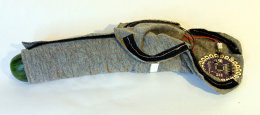Even as we buy more stuff online, clothing remains a holdout for brick-and-mortar retailers. Why? The fitting room.
"I'm not sure people would buy garments without trying them on in reality," says fashion designer Amber Bessey--especially the more expensive ones. But as the line between "reality" and "virtual" begins to fade, even the most traditional designers are beginning to crave the massive distribution power of the web.
A company called CLO Virtual Fashion Inc. is hoping to change the minds of designers like Bessey. The company's software, CLO3D, is a virtual sewing machine, simulating physical properties of materials and streamlining the design process.
Virtual Fitting Room
While retailers have been dabbling in virtual fashion for a while, none have attacked the design process from first stitch.
CEO of CLO USA Simon Kim says designers could use a device called the C-Mirror to make a more interactive experience.
The C-Mirror is a virtual fitting room--it's a real-life mirror that displays CLO3D-made garments over the person's reflection--allowing them to try on clothing virtually.
"Something like haute couture, that normal consumers would never be able to wear--you'd be surprised with how many people would get into that," Kim says.
High-end U.K designers are already using 3-D software, since they have to create their garments in-house and in a more competitive fashion market, unlike the U.S., which outsources most of its apparel.
One of CLO's European clients grew a single clothing line from 300 garments to 1,000. "U.K. designers don't want to increase the capacity by dismantling the traditional culture and philosophy, but they can reduce their lead time through technologies like 3-D," Kim says. "But, I do think we could have those kinds of things in the U.S."
Department stores like Macy's and Bloomingdale's have used virtual fitting rooms and body scanners like Me-ality and TrueFit. Sportswear designer Henri Lloyd reduced return rates by 70% with virtual fitting rooms and online retailers like ASOS--which recently teamed up with software program Virtusize--have been measuring fit. But, today's consumers want more than just proper fit. And, with the prices they are paying, they deserve to get it with software like CLO's.

It's All About The Output
The visual quality of CLO3D-made apparel surpasses competing 3-D garments like Fits.me and Bodymetrics--whose virtual apparel is created by scanning items, digitizers, or photographs and lack realist effects. Thanks to the software's output, CLO3D offers 23 different, realistic fabrics options and even allows designers to customize their own fabrics. You've probably seen CLO's technology before as it is responsible for the realistic garments in movies like The Hobbit and The Adventures of Tintin as well as games like FIFA and Call of Duty.
CLO's output also aids in the software's ability to nail the "draping" effect--the way the clothes naturally hang on a person. Unlike competitors' technology that relies mostly on a slower analog process, CLO3D's simulation engine is so fast that it can create fabrics' most extensive details. "We researched a lot about the sewing techniques and the fabrics and in essence, it's more based on the avatars and how the fabric connects with them," Kim says "And then, how it simulates--it's all about the draping."
The program's collision detection--an effect used in realistic 3-D video games--allows designers to create a garment's layering effect--the biggest component missing from virtual garments. "That's how designers can create puffs, pleats, and padding that they would consider in real life," Kim says. "You can see the draping and get more creative by drawing another pocket and different kinds of details that's completely impossible to do in other programs right now."
Adding Value To Fashion Week
Having reported from the fashion week front lines, I can say that the quality of CLO's virtual fashion show--from the lighting to the model's movement--is visually spot-on. There's an option to change a garment's colors on the avatar while it is walking down the runway--which, if I'm a designer, gives me a million ideas of creative things I could do with that alone.
Kim and the CLO team have been attending Milan Fashion Week to figure out how to get involved in future fashion weeks as soon as next year. And, while he doesn't want to narrow down the market just yet, he does have some ideas of possible uses. "With C-Mirror, I think it would be a good device to show the samples that are not inside the runway that you've already created," he says. "You can actually give more value by showing that you have more designs."
And with more designs, come more designers and more revenue options. Organizations like Mercedes Benz Fashion Week and the Council of Fashion Designers of America (CFDA) could use the virtual fashion show to feature talented designers they aren't able to accommodate in the physical show, creating potential revenue streams and a more inclusive event.
There's also big value in having garment demand data before spending time and money on getting it produced and reducing the risk of not selling. U.K. luxury brand Burberry has been at the forefront of leveraging this kind of big data, reeling in annual sales in excess of $3 billion. It's no wonder Burberry CEO Angela Ahrendts was recently picked up by Apple's management.
SAP Marketing Director David Trites says brands that can extract the most wisdom from the crowd and react to it fastest will win both on and off the runway. "A lot of designers--especially high-profile ones--reject the idea of data influencing their art or their ability to set new trends, " he says. "But, at the end of the day, big data is about gaining knowledge to help make better decisions, so some designers will leverage the insight for their designs--they just won't tell anyone."
Now imagine having that sort of wisdom already inside of the software you use to design an object--yet another potential benefit from CLO's technology.
Scaling The Line Between Tradition And Technology
A former Korean venture capitalist, Simon Kim understands the work it takes to disrupt this business and has been treading lightly. "Fashion is a very traditional industry--unlike other industries," he says. "We started to get in that market but we needed technology advancements to get there, which took more than two years."
To keep a competitive edge, early adopters of the product are keeping their affiliation with the product confidential, as 10 of its 100 clients are high-profile brands. "3-D adoption is somewhat of a bigger strategic business decision for many," says CLO's vice president of Business Development, Deborah Park. "This technology is not the future--it's actually now," Kim adds. "If you have the technology ready, the actual success of business really depends on how to communicate with people and catching the trends."
But not all tradition needs preserving--especially not the currently chaotic manufacturing system which involves a lot of time, money, and guesswork. The typical production process requires designers to attach 2-D drawings to an assortment of attachments and glued fabrics, followed by multiple shipping rounds to China. And, for the majority of U.S. apparel brands that are outsourcing, communication between factories is often difficult, delayed, and problematic.
CLO3D enables instant creation, edit options, and accurate measurement directly inside the program, making the average garment creation time a mere 35 minutes and an average lead time of 72 hours for a physical sample. One of CLO's clients saved $68.5k on a single clothing line, cutting the average time and cost in half.
Fashion designer Amber Bessey says CLO3D's concept is a serious development in the design process. "As a designer that does sketches completely on the computer, it would be very helpful," she says. "It seems like a natural but exciting technology which can help the designer visualize concepts before ever making a pattern."
Iowa State University professor Fatma Baytar says this kind of technology is needed in the design process. "It's better to have a more sustainable system where we don't have to create a bunch of garments, but customize fewer, quality garments for the consumer."
It's the company's patience with the fashion industry that will make it more of a success over competitors in the long run. But, Kim says the process will continue to need physical skills like pattern making. "We don't go to the client and say, 'We want to replace everything in 3-D'. We are trying to contribute to their processes so it can be easily adaptive, so they can benefit from it and so that it slowly gets the culture going," he says. "In fashion, you have to be very careful to get the right cultural fit as well."
New Roots To Dress The World
After researching several locations, the company decided to lay new global grounds in New York last month, where Kim believes is the perfect spot for overlooking European and South American markets--especially China. "The sheer amount of garments made in China--it's just too much," he says. "We need to be there."
In order to become the go-to fashion platform the founders envision, Kim says the company is using 2014 to nail down a sustainable model that can cope with the varying design processes around the world. "Every single retailer and designer has their own process--a designer in Brazil will have a different process than the U.S. or the Italians," he says. "We want to continue talking with them and advance the technology so it can cooperate with them all."
Though CLO is in a predominately B2B position right now, the company doesn't plan to stay there. Founders have ideas for the consumer side including a virtual shopping mall and virtual fitting rooms within mobile devices and wearables.
But Kim says it will have to wait for hardware efficient enough to hold CLO3D's considerable computer power. "It's a matter of the hardware which is not there yet," Kim says. "You could imagine that with the Google Glass you can actually have some suits or dresses worn by people walking around you."























